
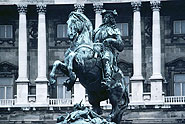
Perhaps the greatest of the Austrian military heroes, Prince Eugene of Savoy (from a small principality in northern Italy) had initially offered his services to Austrian arch-rival France. Here we see a famous statue of him erected in 1809 in the "Heroes' Square" next to the Habsburg winter palace, the Hofburg, right in the center of Vienna. The sculptor, Anton Dominik Fernkorn, was copying a common way of representing military heroes or political leaders on a rearing horse. A number of paintings in the museum also follow this convention.
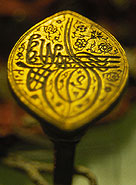
Slighted by what he perceived as inadequate rewards, Prince Eugene transferred his loyalty to Vienna and achieved his fame in the Turkish wars. One of the most significant battles of the Austrian wars against the Turks was Prince Eugene's victory achieved at Zenta on the Tisza River in 1697. This was an era in which news spread rapidly through the periodical press as well as in "Extras" published as broadsides or small pamphlets and distributed by the European postal network. Several different accounts of the Battle of Zenta were even translated in distant Russia, which had become an ally of the Austrians in the wars against the Turks. Among the objects captured by Prince Eugene was the gold seal of Sultan Mustapha II, which displays his monogram (tughra) that reads, ironically, "Mustapha, Son of Muhammad Khan, ever victorious," and contains the date of his accession to the throne, 1106 A.H. (after the Hijra, according to the Muslim calendar) or 1695 CE.
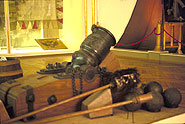
When the Turkish wars resumed in the early eighteenth century, Prince Eugene presided over the effort in 1717 to subdue the nearly impregnableTurkish-held fortress of Belgrade. In a sense, the hero of the occasion was this ten-pound mortar, cast in Vienna in 1714, and its anonymous gunner. A shot from the mortar exploded the Turkish powder magazine on August 14, 1717 and thus destroyed a major part of the city.
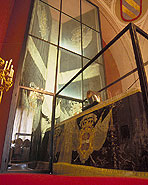
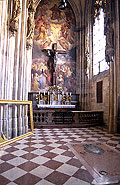
The museum collection contains portraits and personal belongings of Prince Eugene, whose prominence is also underscored by his palaces and statues out in Vienna itself. At his death in 1736, he was honored with a state funeral of unequalled pomp. His funeral pall displays the arms of Savoy on the side, with the flanking flags listing his most important victories. The museum display includes the various hangings used during the impressive state funeral in 1736 as well as the prince's cuirass (breastplate), sword and commander's baton. Other exhibits show some of his clothing. The great commander was a man of small stature physically, even though the contemporary portraits and the prominent equestrian statue of him in front of the Habsburg palace, the Hofburg, present him as larger than life. He was buried in the great cathedral of St. Stephen, the Viennese equivalent to Westminster Abbey in England, in a chapel specifically dedicated to honoring him.